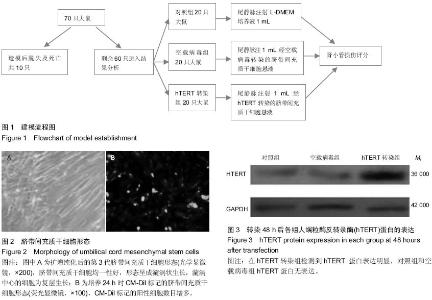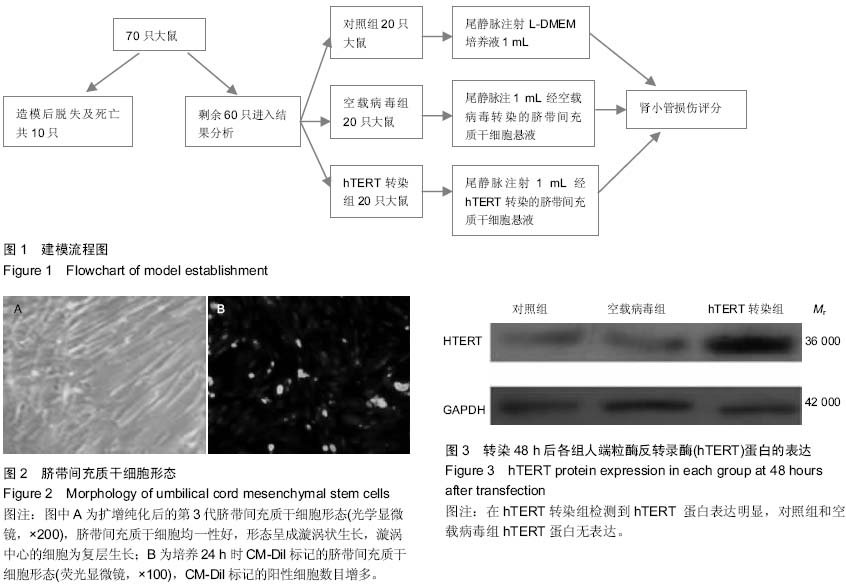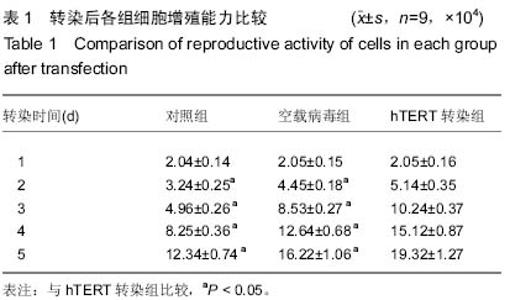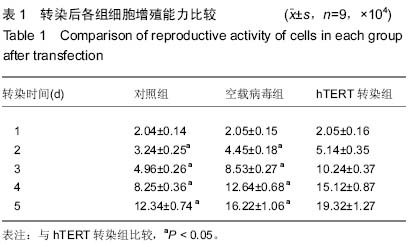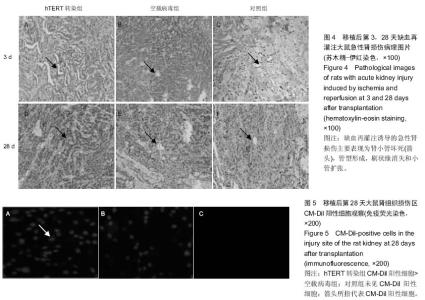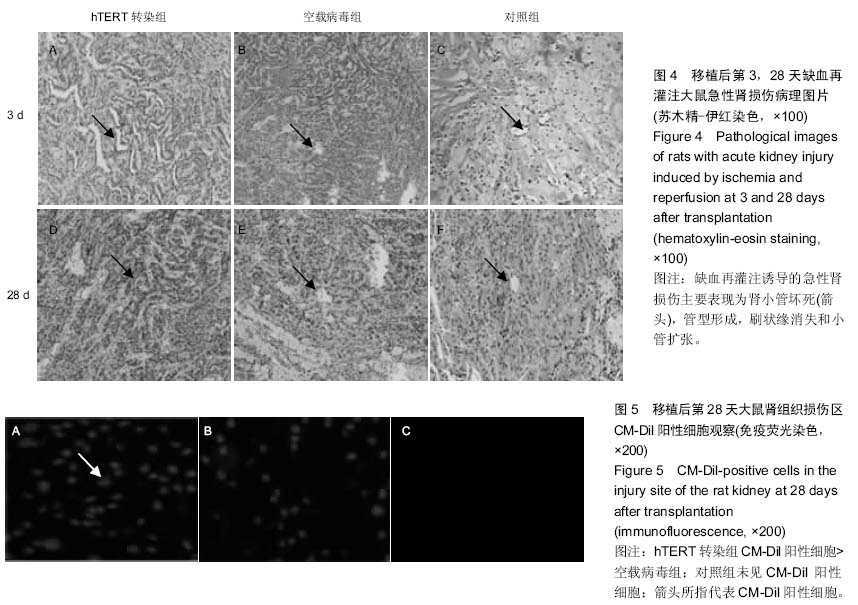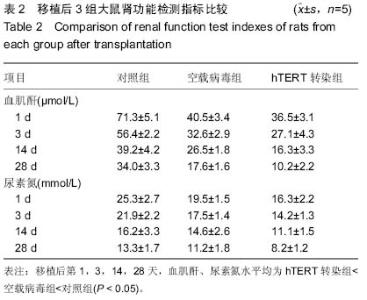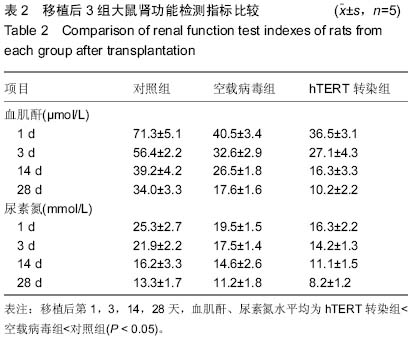| [1] 杨婷,陈广华,薛胜利,等.无血清和含胎牛血清培养基培养的脐带间充质干细胞生物学特性比较研究[J].中华血液学杂志,2012, 33(9):715-719.
[2] 杨大志,罗惠莉,易伟宏,等.转染骨形态发生蛋白-2基因的人脐带间充质干细胞成骨研究[J].中华实验外科杂志,2012,29(8): 1580-1583.
[3] 毛立军,李望,杨春华,等.SATB1、hTERT基因在前列腺癌组织中的表达及其临床意义[J].中华实验外科杂志,2011,28(4): 603-604.
[4] 杨磊,丁巍,张敏敏,等.NF-κB在醛固酮所致大鼠肾损伤中的作用及相关机制[J].中华肾脏病杂志,2011,27(9):673-677.
[5] 沈建明,叶婷婷,王黎萍,等.依达拉奉对心肺复苏后大鼠肾损伤的保护作用及其机制[J].中华实验外科杂志,2009,26(6):778-779.
[6] 侯玉森,柴家科,刘玲英,等.脂多糖预处理对人脐带间充质干细胞内毒素耐受的影响[J].中华医学杂志,2014,94(12):948-951.
[7] 张险峰,江应安,印安宁,等.端粒酶反转录酶基因启动子调控FADD表达载体诱导人结肠细胞凋亡的研究[J].中华实验外科杂志,2011,28(7):1139-1179.
[8] 寇晨程,陈丑彦,曾峰,等.大鼠肾损伤早期三七总皂苷对肾皮质小管细胞Bax的影响[J].中华创伤杂志,2014,30(2):185-188.
[9] 严波,陈方敏,石家齐,等.人端粒酶反转录酶基因反义核酸结合位点的筛选[J].中华实验外科杂志,2011,28(12):2101-2104.
[10] 华杰,龚健,何志刚,等.血小板裂解液替代胎牛血清培养间充质干细胞[J].中华实验外科杂志,2014,31(4):744-746.
[11] 程文,苏筠,马宏青,等.联合RNA干扰TR及TERT对膀胱移行细胞癌BIU-87细胞株端粒酶活性及其增殖的影响[J].中华医学杂志, 2009,89(40):2847-2852.
[12] 王丹,暴一众,胡昱兴,等.螯合剂BPCBG对急性铀中毒大鼠的促排效果及肾损伤的保护作用[J].中华放射医学与防护杂志,2012, 32(4):337-341.
[13] 胡志娟,任路平,王超,等.鹅脱氧胆酸对高果糖饮食致大鼠肾损伤的保护作用及其机制[J].中华肾脏病杂志,2013,29(2):129-135.
[14] 沈干,丛笑倩.小鼠胚胎干细胞分化细胞永生化后致瘤性研究[J].中华整形外科杂志,2012,28(1):33-39.
[15] 卢文艺,赵明峰,柴笑,等.活性氧介导铁过载对脐带间充质干细胞及其造血支持作用的研究[J].中华医学杂志,2013,93(12): 930-934.
[16] 王劭亮,王卫星,余建华,等.罗格列酮保护大鼠重症急性胰腺炎肾损伤的机制[J].中华实验外科杂志,2012,29(5),896-899.
[17] Ttigel F, Hu Z, Weiss K, et al. Administered mesenchymal stem cells protect against ischemic acute renal failure through differentiation—independent mechanisms. Am J Physiol Renal Physiol. 2005;289:F31-F42.
[18] Mias C, Trouche E, Seguelas MH, et al. Ex vivo pretreatment with melatonin improves survival, proangiogenic/mitogenic activity, and efficiency of mesenchymal stem cells injected into ischemic kidney. Stem Cells. 2008;26:1749-1757.
[19] Chen YT, Sun CK, Lin YC, et al. Adipose-derived mesenchymal stem cell protects kidneys against ischemia— reperfusion injury through suppressing oxidative stress and inflammatory reaction. J Transl Med. 2011;9:51-67.
[20] 曾慧兰,钟启,贾海涛,等.氯化钴作用人脐带间充质干细胞的差异蛋白质组学分析[J].中华血液学杂志,2011,32(11):739-743.
[21] 马西臣,谭玉利,杨亦彬,等.肾损伤分子1在鱼胆中毒大鼠尿和肾脏的表达[J].中华肾脏病杂志,2009,25(4):322-323.
[22] 胡凡果,只向成,史玉荣,等.人端粒酶反转录酶shRNA抑制乳腺癌T47D细胞增殖活性的研究[J].中华实验外科杂志,2013, 30(4): 667-670.
[23] 孙东翀,杨勇,魏志涛,等.人脐带间充质干细胞与肌肉微粒共培养及其诱导干细胞成肌分化的研究[J].中华实验外科杂志,2013, 30(2):339-341.
[24] 陈绍坤,刘岚,税青林,等.联合干扰人端粒酶反转录酶和端粒重复序列结合因子2基因的表达对乳腺癌MCF-7细胞生长的抑制作用[J].中华肿瘤杂志,2010,32(2):93-97.
[25] 方明星,董士民.亚甲蓝预先给药对脓毒症诱发大鼠急性肾损伤的影响[J].中华麻醉学杂志,2014,34(2):241-244.
[26] 翟晓东,陈振雨,冷向锋,等.局部移植人脐带间充质干细胞治疗大鼠皮瓣缺血再灌注损伤[J].中华整形外科杂志,2012,28(3): 203-207.
[27] 马群兴,李彤,赵越,等,脐带间充质干细胞与脐血CD34+细胞联合移植治疗心肌梗死[J].中华胸心血管外科杂志,2014,30(2): 82-89.
[28] 高加胜,刘荣福.间充质干细胞在急性肾损伤中的研究进展[J].国际泌尿系统杂志,2012,32(4):549-552.
[29] 范宁建,冯世庆,刘举,等.人脐带间充质干细胞联合布洛芬修复大鼠脊髓损伤[J].中华实验外科杂志,2013,30(1):112-114.
[30] 刘少鹏,俞小芳,钟一红,等.经肾动脉移植脂肪干细胞对大鼠急性缺血性肾损伤的治疗作用[J].中华肾脏病杂志,2013,29(10): 768-774.
[31] 宋扬,徐韬,杨明坤,等.RNA干扰hTERT基因慢病毒表达载体的构建及鉴定[J].中国组织工程研究,2014,18(11):1724-1729.
[32] Ninichuk V, Gross O, Segerer S, et al. Multipotent mesenchymal stem cells reduce interstitial fibrosis but do not delay progression of chronic kidney disease in collagen4A3- deficient mice. Kidney Int. 2006;70(1):121-129.
[33] Zhou K, Zhang H, Jin O, et al. Transplantation of human bone marrow mesenchymal stem cell ameliorates the autoimmune pathogenesis in MRL/lpr mice. Cell Mol Immunol. 2008;5(6): 417-424.
[34] 吴灵芝,李水彬,程刚卫,等. hTERT基因转染对人神经元活力的影响[J].赣南医学院学报,2014;34(2):170-173.
[35] 靳斌,王伟,刘泽阳,等.外源hTERT基因转染对老年大鼠供肝缺血再灌注损伤的防护作用[J].山东大学学报:医学版,2013,51(8): 13-16.
[36] Qiu Z, Zhou D, Sun D. Effects of human umbilical cord mesenchymal stem cells on renal ischaemia-reperfusion injury in rats. Int Braz J Urol. 2014;40(4):553-5561.
[37] Shalaby RH, Rashed LA, Ismaail AE, et al. Hematopoietic stem cells derived from human umbilical cord ameliorate cisplatin-induced acute renal failure in rats. Am J Stem Cells. 2014;3(2):83-96.
[38] Jang HR, Park JH, Kwon GY, et al. Effect of preemptive treatment with human umbilical cord blood-derived mesenchymal stem cells on the development of renal ischemia-reperfusion injury in mice. Am J Physiol Renal Physiol. 2014;307(10):F1149-F1161.
[39] Peng X, Xu H, Zhou Y, et al. Human umbilical cord mesenchymal stem cells attenuate cisplatin-induced acute and chronic renal injury. Exp Biol Med (Maywood). 2013; 238(8):960-970.
[40] Peng X, Xu H, Zhou Y, et al. Human umbilical cord mesenchymal stem cells attenuate cisplatin-induced acute and chronic renal injury. Exp Biol Med (Maywood). 2013.
[41] Dorronsoro A, Robbins PD. Regenerating the injured kidney with human umbilical cord mesenchymal stem cell-derived exosomes. Stem Cell Res Ther. 2013;4(2):39.
[42] Zhou Y, Xu H, Xu W, et al. Exosomes released by human umbilical cord mesenchymal stem cells protect against cisplatin-induced renal oxidative stress and apoptosis in vivo and in vitro. Stem Cell Res Ther. 2013;4(2):34.
[43] Li W, Zhang Q, Wang M, et al. Macrophages are involved in the protective role of human umbilical cord-derived stromal cells in renal ischemia-reperfusion injury. Stem Cell Res. 2013;10(3):405-416.
[44] Fang TC, Pang CY, Chiu SC, et al. Renoprotective effect of human umbilical cord-derived mesenchymal stem cells in immunodeficient mice suffering from acute kidney injury. PLoS One. 2012;7(9):e46504.
[45] Park JH, Hwang I, Hwang SH, et al. Human umbilical cord blood-derived mesenchymal stem cells prevent diabetic renal injury through paracrine action. Diabetes Res Clin Pract. 2012;98(3):465-473. |
